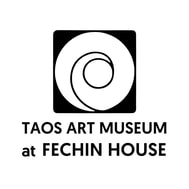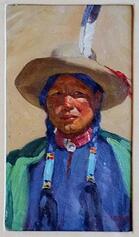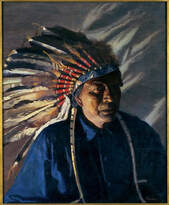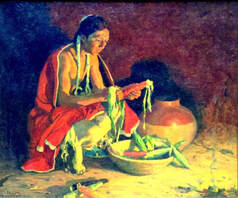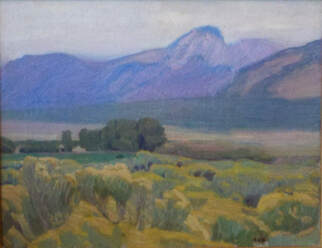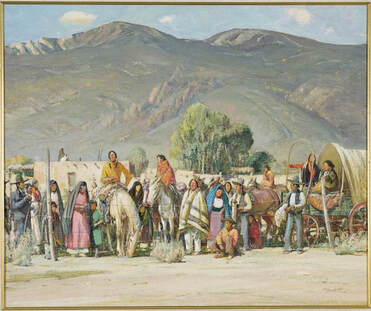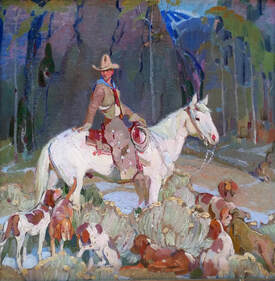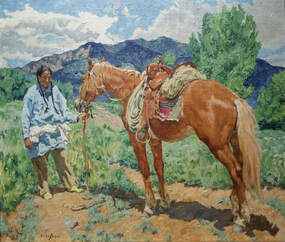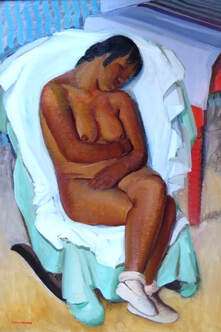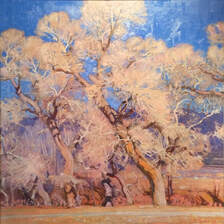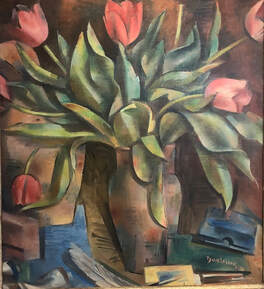HISTORY OF THE TAOS SOCIETY OF ARTISTS
The artist Joseph H. Sharp first visited Taos while on a sketching trip in 1883 and was captivated with its enchanting atmosphere. He is often referred to as the artist who "started it all." Later, while studying in Paris, he shared his enthusiasm with two artist friends, Bert G. Phillips and Ernest L. Blumenschein. As a result of a broken wagon wheel on September 3, 1898, the two artists stayed in the Taos area instead of completing their scheduled trip to Mexico. Back in Paris, Blumenschein met E.I. Couse and told him of a mystical mountainous region. Intrigued, Couse was also inspired to explore Taos. Oscar E. Berninghaus joined the Taos artists, and with the addition of Herbert Dunton, a painter of cowboys and ranch life, the "Founding" group numbered six. On July 1, 1915, the Taos Society of Artists held its first meeting. The proposed purpose of the association was to promote the showing and sale of their work.
The group then met Walter Ufer and Victor Higgins and voted them in as Active Members in July 1917. Julius Rolshoven became an Associate Member in 1917 and then an active member in 1918. E. Martin Hennings became an Active Member in 1924. The only woman of the group, Catherine C. Critcher, became an Active Member also in 1924. And Kenneth Adams, the last and youngest of the group, became a member in 1926, only one year before the group disbanded.
The group then met Walter Ufer and Victor Higgins and voted them in as Active Members in July 1917. Julius Rolshoven became an Associate Member in 1917 and then an active member in 1918. E. Martin Hennings became an Active Member in 1924. The only woman of the group, Catherine C. Critcher, became an Active Member also in 1924. And Kenneth Adams, the last and youngest of the group, became a member in 1926, only one year before the group disbanded.
|
Joseph Henry Sharp (1859-1953)
A childhood hearing loss curtailed Sharp’s conventional schooling in his native Bridgeport, Ohio. Still, his artistic skill enabled him to enroll at the McMicken School of Design in Cincinnati at fourteen. In 1881 he went off to Europe, the first of three study trips abroad, followed by visits to New Mexico and the Columbia River basin. Sharp spent part of 1893 in Taos and passed on word of its artistic resources to Ernest Blumenschein and Bert Phillips, whom he had met in Paris in 1895. For two decades, he divided his time between teaching at the Cincinnati Art Academy, sketching in the Northwest, and summering in Taos, where he ultimately established a permanent residence in 1912. Sharp drew and painted with a facility and accuracy that gave his work ethnographic and artistic value. |
|
Bert Geer Phillips (1868-1956)
Born in Hudson, New York, Phillips began drawing before he could write. As a small child, he won first prize at the county fair for a collection of watercolors. After studying at the Art Students League and the National Academy of Design, Phillips set up a studio in New York, where he painted for the next five years. He then spent seven months in England, where he produced some charming watercolors of pastoral scenes. Finally, in Paris, Phillips studied at the Academie Julien, where he met Joseph Sharp and Ernest Blumenschein. In 1899, he married Rose Martin, an eastern girl visiting her brother, Dr. T. P. Martin. It was at Dr. Martin's house in 1912 that the Taos Society of Artists was organized. |
|
Eanger Irving Couse (1866-1936)
In 1886, after attending classes at the Art Institute of Chicago and Art Students League in New York, Couse went to Europe, where he remained for nearly ten years. While in Paris, he studied with the academic master Adolphe Bouguereau and frequently exhibited at the Salon. Couse first became interested in western subject matter after visiting his father-in-law’s sheep ranch in Oregon. In 1909 he established a studio in Taos, dividing his time between the Southwest and New York. Couse concentrated primarily on Native American portraits. When he died in 1936, he was among the best-known members of the Taos Society of Artists, producing more than fifteen hundred oil paintings. |
|
Ernest Blumenschein (1874-1960)
Born in Pittsburgh and raised in Dayton, Ohio, Blumenschein received a scholarship to study violin at the Cincinnati Conservatory when he was seventeen. After a year of music training, however, he chose to follow his interest in art. Blumenschein studied first at the Cincinnati Art Academy, then at the Art Students League in New York, and the Académie Julian in Paris, where he met Joseph Henry Sharp and Bert G. Phillips. From 1910 until 1918, he spent summers in Taos and the rest of the year in New York, where he worked as an illustrator and taught at the Art Students League. He moved to Taos permanently in 1909. His colleagues regarded him as the most accomplished painter of the group. |
|
Oscar E. Berninghaus (1874-1952)
Oscar E. Berninghaus, born in St. Louis, Missouri, displayed his inclination for art at an early age. At sixteen, he quit school to work for a lithography company and later attended night classes at the School of Fine Arts in St. Louis. In 1899, the Denver and Rio Grande Railroad hired him to travel west to sketch and produce watercolors of the mountain scenery, people, and villages. During this journey, Berninghaus encountered the magic of Taos. He continued to return to Taos almost every summer for the next twenty-five years and moved there permanently in 1925. As early as 1905, his work received critical acclaim in the newspapers, with some writers comparing him to Frederic Remington. For most of his artistic career, Berninghaus painted models from life and landscapes from nature. In later years, however, his repertoire of stored images was so extensive that he could paint from memory as accurately as he had once painted from life. |
|
W. Herbert "Buck" Dunton (1878-1936)
Dunton traveled extensively in the West as a young man, working as a ranch hand and cowboy. When he became a commercial illustrator, Dunton used this experience to authenticate details in sketches commissioned by such periodicals as Harper’s, Collier’s, and Scribner’s. A desire to study painting more seriously brought him in 1912 to the Art Students League, where his teacher, Ernest Blumenschein, suggested a visit to Taos. Dunton responded immediately to the pictorial richness of New Mexico, finding his favorite subjects in the wildlife and rugged mountain men of the region. During the Depression, suffering financially and increasingly in poor health, Dunton worked on the Public Works of Art Project murals and practiced lithography. His concern for preserving the vanishing spirit of the Old West exceeded that of all his artist colleagues in Taos. |
|
Walter Ufer (1876-1936)
Walter Ufer was born in Huckeswagen, Germany. At the age of four, Ufer moved with his family to Louisville, Kentucky, where he grew up and trained as a lithographer. Ufer decided on a painting career after visiting the World’s Columbian Exposition in Chicago. He began his studies in Hamburg and then moved on to the Royal Academy in Dresden. In 1900 he took up commercial art and portrait painting in Chicago, but he went to Munich in 1911 for further study. When he returned, his talent attracted former Chicago mayor Carter Harrison, who offered to subsidize a trip to Taos in 1914. There Ufer soon abandoned studio methods in favor of working outdoors in direct sunlight. His favorite subjects were Indians absorbed in their daily activities or traveling across the brilliant landscape. In 1920 he became the first Taos artist to win a prize at the Carnegie International, and through the rest of the decade, his dazzling brand of Impressionism retained considerable appeal. |
|
Victor Higgins (1884-1949)
At fifteen, Victor Higgins defied his parents’ wishes and left his native Indiana for Chicago, where he studied at the Art Institute and the Academy of Fine Arts. Sponsored by ex-mayor and collector Carter Harrison, Higgins spent two and half years researching and traveling in Europe. While in Munich, he associated with fellow art students Walter Ufer and Martin Hennings. In 1914 Harrison sent him on a painting trip to New Mexico. Higgins found the intense light, brilliant color, and lure of the land a powerful antidote to the confines of academic training. He joined the Taos Society of Artists in 1917. Still, he continued to divide his time between Chicago and Taos for some years and exhibited in Indianapolis and New York, with an occasional painting sent to Europe. As a link between his more conservative colleagues and the emerging artistic developments of the twentieth century, Higgins wedded theory to his own intuitively derived visual harmonies. The result was a rich and varied body of work in still life, figure painting, and, most significantly, landscape. |
|
E. Martin Hennings (1886-1956)
After graduating from high school, Hennings left his native Pennsgrove, New Jersey, for five years of study at the Art Institute of Chicago. His training continued with two years at the Royal Academy in Munich. Fellow art students in Munich included Walter Ufer and Victor Higgins. In 1914, at the outbreak of World War I, Hennings returned to Chicago, where he made his living as a muralist and commercial artist. At the urging of former Chicago mayor Carter Harrison, Hennings spent a few months in Taos in 1917. Four years later, he made Taos his permanent home, joining the Taos Society of Artists in 1924. His compositions, featuring stylized linen, decorative patterns, and warm colors, won him twelve national prizes between 1916 and 1938. |
The Taos Art Museum completes its collection of work by Taos Society of Artists members with paintings by Julius Rolshoven, Catharine Carter Critcher, and Kenneth Adams.
|
Following the Taos Society Artists
During the 1920s and 1930s, there was an influx of artists who showed tendencies toward modernism. Andrew Dasburg (1887-1979) arrived in Taos in 1918 and was a key proponent of modernism and cubism. In Taos, Dasburg became a mentor to a group of artists known as "Taos Moderns." Kenneth Adams, Ward Lockwood, Barbara Latham, and Howard Cook were some of the artists influenced by Dasburg. They came to Taos and spent their careers there. Lockwood, Latham, and Cook eventually settled in Dasburg's neighborhood on the north Talpa ridge. Artists enjoyed painting the Picuris Mountains to the south, patterns created by strip farming, and adobe houses seemingly growing out of the terra firma. The Taos area has grown to become a renowned international art market and artists' community. It is estimated there are more artists, per capita, in the Taos area than in any other city in the world, including Paris, France. |
Taos Art Museum at Fechin House
227 Paseo del Pueblo Norte
Taos, New Mexico 87571
(575) 758-2690
[email protected]
Taos Art Museum is a tax-exempt non-profit, #85-0400684
227 Paseo del Pueblo Norte
Taos, New Mexico 87571
(575) 758-2690
[email protected]
Taos Art Museum is a tax-exempt non-profit, #85-0400684
